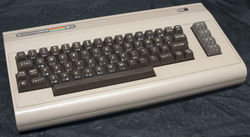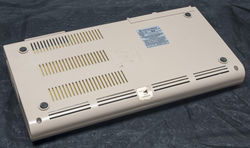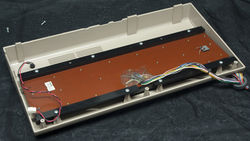Commodore 64
| This article requires additional photographic illustration |
 | |
| Branding | Commodore |
|---|---|
| Manufacturer | Mitsumi (keyboard) |
| Keyswitches |
Mitsumi KSR Type Possible Mitsumi clone |
| Keycaps | Spherical sculptured ABS, double-shot or pad-printed. |
| Rollover | 2KRO |
| Years of production | 1982-1994 |
| Precedes | Commodore 128 |
| Supersedes | Commodore VIC-20 |
The Commodore 64 (also called C64) was an 8-bit home computer with an integrated keyboard. It carries the title of being the highest-selling single computer model of all time.
Contents
Description
All keyboard variations are interchangeable with each other and with the keyboard of the C64's predecessor, the Commodore VIC-20. The keycaps are sculptured and spherical high-profile.
Typical keyboards used the Mitsumi KSR Type mechanism with a PCB. Into the PCB is fitted a discrete latching action switch for Shift lock; this switch is exceptionally smooth for a latching switch. The sliders use a cruciform mount instead of the more common square Mitsumi mount. The keyboard PCB model across all variants (C64, C64C and C64G) is KSR-A66YF.
Like other 8-bit computers of the time, the keyboard is scanned by the main CPU itself: a derivative of the MOS 6502 running at approx 1 MHz (Slightly different for PAL and NTSC regions). The 8×8 matrix is connected to I/O chips that reuse the same pins for other things, such as joystick ports. A joystick in port 1 can interfere with the keyboard's operation. If a game scans only for the Space bar, pressing the Fire button on a joystick in port 1 would activate it. Therefore, many games do use the Space bar for an alternate action, and some joysticks connect two ports to have an alternate button press Space.
Layout
The keyboard layout is from the Commodore VIC-20, with lineage back to the Commodore PET line of office computers.
The alphanumeric area is 16.25u wide, with Return and Del keys far right. To the right of it, there is a column of four function keys. The function keys have odd numbers: even numbers are acquired with Shift.
There are two cursor keys right of the right Shift key. They are Down and Right respectively but reversed with Shift. Together they can be operated with three fingers on one hand.
The C64 has two character sets in ROM, called PETSCII, based on the 1963 version of ASCII with a ← instead of _ and ↑ instead of ^. Commodore also put the £ sign instead of \. The default unshifted set is all-caps. In BASIC mode, pressing Shift+Commodore switches to/from the shifted set which has lower-case characters also. The switch changes only a pointer to a different place in the character ROM: upper-case chars become lower-case, and graphics chars become upper-case. Upper and lower case characters in the shifted set are swapped compared to regular ASCII.
Most of the character set is occupied by graphics characters: line drawing, blocks, playing card colours and pi, and "reverse text mode" forms of those. The non-reversed graphic characters are printed on the front (later: on top) of the alphabetic and symbol keys, They are accessible with the Commodore modifier, and Shift (unshifted set only). Commodore + <number> changes the text colour, and for entering/leaving "reverse text mode".
There are a few different country-specific keyboards with different layouts but instead of different keycaps the keys that differed from the English norm had stickers with new legends. These C64s came with different kernal ROMs with different character-scanning routines. The character set did also not support all letters so the character ROMs had character graphics in some code spaces replaced with others.
Variations
Original Commodore 64
The alphanumeric keys are double-shot white on a very dark brown. The front-printed "PETSCII" legends are likely pad-printed.
Most keyboards have dark grey function keys but some have orange, similar to the VIC-20's. Some VIC-20s have also been spotted with grey function keys, but that is more unusual. The reason why is unknown: one theory is that the orange was the original for both, and that grey is just a later variation. Another theory is that factories sometimes ran out of the intended variation and not being picky, used whatever they had on hand to meet demand. The letter font on both variants is narrow (as opposed to PET-style wide letters on early VIC-20).
The "bread-bin" enclosure is also similar to that of the VIC-20 but has a warmer beige hue (called RAL1019) and different port openings on the bottom half. On early cases, the top is interchangeable with the VIC-20's. Later "bread-bin" C64 cases are slightly lower in height with no interchangeable part with the earlier cases. An even later variation has embossed port labels.[1]
Commodore 64 Golden Series
A limited edition made in 1984 to celebrate 1 million units sold. Has a gold-painted "bread-bin" case, with main keys in light beige and function keys in medium grey. Top legends are black, and front legends are gray. It is unknown how many were made, but it has been estimated to be max 350.[2]
Commodore 64C
Released in 1986, the enclosure was changed to a flatter, sleeker variant with a brighter hue, in a design style that it shares with the Commodore 128 and later Commodore Amiga models with integrated keyboards. This was made possible by having a smaller logic board with updated hardware. The keyboard is also moved forward and slanted more.
The 64C revision keyboard has been seen with what appears to be a Mitsumi standard mechanical latching switch for shift lock.[3] This offers a suggestion as to the age of this switch.
The keys are now light beige, with medium gray function keys. (Possibly the same keyboard as on the Golden C64)
Commodore 64 Aldi
Made in 1987 especially for German supermarket chain Aldi. It was a C64C but put into a classic "bread-bin" case. Light beige keyboard.[2]
Commodore 64C CR
A cost-reduced version of the C64C, released in 1988. Cheaper case that is snapped together, not bolted.
All legends are pad-printed on top of the keys, in a different rounder font. Legends on modifier keys are on top/left instead of centred.
Commodore 64G
A 1988 variant released in Europe, believed to be primarily for the German market.[2] Has a bread-bin case but in brighter beige like the C64C, and with a reputation for being cheap and brittle.
The keyboard varies between specimens: it could be the cost-reduced variant or not.[4]
Unidentified keyboard
Some Commodore 64 computers use an unidentified keyboard with Mitsumi-style sliders, but with an SMK J-M0404 series switch for Shift Lock.[5] Typically, keyboards sourced from other manufacturers use whatever switches they have in their product range, but here, it looks like an attempt was made to clone the Mitsumi KSR switch mechanism. The PCB is marked "ACTION", which may indicate the manufacturer. The Mitsumi manufacture date label is also absent.
Gallery
- Commodore 64
Mods
Aftermarket parts
- Australian C64C case
- A C64C-lookalike case made by Micro Accessories in South Australia, released in 1986. The vents and LED position don't match, and is not marked "Commodore 64".
- New C64C cases
- Made from original tooling, 2014 onwards. First vendor made them in white, blue, red, and clear plastic that did not yellow. Second vendor made them in C64C-beige, breadbin colour, black and two-tone SX-64 style.
- New keycaps
- New keycaps in new tooling, in both classic colours and to match new coloured C64C cases, in PC+ASA plastic that does not yellow. Top-pad-printed legends in C64C-CR style. No Commodore logo for trademark reasons. [6]
- New C64 breadbin cases
- An ongoing Indiegogo campaign by Retro Fuzion. Can be ordered in multiple colours that don't yellow as easily, four choices of power LED, coloured side-bracket, brass screw inserts. Estimated shipping in Dec 2024. [7]
Replacement keyboards
- Archer 65 Position Multiplexed Output keyboard
- Apparently the official replacement keyboard from Commodore, who liquidated a large quantity of surplus keyboard mechanisms for the Commodore 16 computer through Radio Shack under cat. no. 277-1027. Allegedly compatible with the Commodore 64(C) and the Vic 20.
- MechBoard64
- Comes with yellow, red or blue-stemmed Gateron switches and 3D-printed keycap adaptors for original keycaps. Sold in batches.
- MeC64
- A kit for Cherry MX switches, made in a small run. Made for 3D-printed adaptors for use of the original keycaps. Has a USB configuration where it supports two digital joysticks.
- Thread Iceberg's replacement keyboard
- Deskthority user iceberg is building a replacement keyboard with hand-wired Cherry MX switches. A group buy for plates was planned.
- CBMSTUFF's mechanical replacement keyboard
- Indiegogo campaign for a mechanical keyboard and keycaps. Larger keys have the switch in the centre, unlike the original keyboard and replicas that use stem adapters. Has options for being external USB keyboard or an external C64 keyboard.
Ortho-Leaning on Geekhack designed 3D-printed adaptors for 1.5u keys centred on Cherry MX key switches.
Conversion to USB
Guts replaced with keyboard controller:
- Simon Inns' C64 VICE Front-End.
- DIY project based on a PIC microcontroller. Also has joystick and paddle inputs.
- C64key
- DIY project based on a ATmega8 or ATmega16 microcontroller. No joystick support.
- Keyrah KeyRah V2b
- Commercial adaptor with support also for VIC-20, C128, C128D, C16, C116, Plus/4, Amiga 1200 and Amiga 600. Digital joystick ports, translated to key presses.
- Tynemouth Software
- Offers different kits: USB keyboard only, USB keyboard and USB joysticks, and "time-shared" keyboard: USB keyboard when the host Commodore 64 is switched off.
Lookalikes
Keycap sets
The SA Retro keycap set[8] for Cherry MX in SA profile has been made with Commodore-logo keys and with front-printed "PETSCII" legends mimicking the C64's as an option. Options also include modifier keys in burgundy and green based on the colours of the ICL One Per Desk.
C64x / My64
The Commodore 64x, later My64 is a micro-ITX PC in a Commodore 64 "breadbox"-styled case.
It was introduced as "Commodore 64x" in 2011 by Commodore USA LLC, but discontinued in 2012 when the company went out of business after the death of its founder. Commodore USA sold it both as a barebones kit, and in a few outfitted configurations. It had a special Linux distribution called Commodore OS Vision, based on Linux Mint.
The case moulds and some stock were later acquired by MyRetroComputer Ltd in the UK. They started making barebones kits available again in 2020 as the "My64" without the Commodore branding. There is also a VIC-20-themed My Vic20.
The integrated keyboard is built by TG3. It has Cherry MX switches and a modernised layout with inverse-T cursor keys and media key functions on the grey f-column. It connects to the motherboard via an internal USB header cable. The keycaps are Signature Plastics SA family, spherical but not sculptured like the original.
The case fits a motherboard in mini-ITX form factor but no discrete graphics card. It also fit an internal optical drive, a SD-card reader and a 40 mm cooling fan.
TheC64
TheC64 is a 2019 "retro-console" running C64 or VIC-20 software in emulation on a ARM-based single-board computer. It has built-in games, but can also run the BASIC interpreter and load other software over USB. What sets it apart from other retro-consoles (including its predecessor TheC64 Mini) is that it is the same size as the original (first, larger bread-box) and has a working keyboard.
The keyboard mimics the original brown keyboard with front-printed legends and grey function keys. The Commodore key has the legend "The C64" for copyright reasons. It has rubber dome-on-membrane switches with a steel backplate, and unlike the original, the Shift Lock key is not latching. The keycaps, which have square integrated mount, are of white ABS that have been painted, and the legends are probably laser-ablated to reveal the white plastic underneath.[9]
There is a separate controller board, with four wires, of which two are marked D+ and D-,[10] which means that it probably speaks USB. It also has the power-on light.
See also
- Commodore VIC-20 — Predecessor with largely the same keyboard
- Commodore SX-64 — A portable variant of the Commodore 64, with a distinct keyboard.
- Educator 64 — A schoolteacher version of the Commodore 64 in a PET case with integrated monochrome monitor. The keyboard is similar but lacks front-printed colour-change codes.
- Commodore 128 — Backwards-compatible with the Commodore 64. The keyboard is a superset of the Commodore 64's.
References
- ↑ Youtube — Commodore 64 minutia! Fat vs Slim, breadbin Case Differences by Adrian's Digital Basement. Dated 2018-05-14. Retrieved 2024-04-19.
- ↑ 2.0 2.1 2.2 Youtube — All Commodore 64 Models by RetroGameCouch. Dated 2016-04-15. Retrieved 2024-04-19.
- ↑ Vintage Computer Federation forum — My quest for a Commodore 64 (Wayback Machine) Archived 2019-04-14.
- ↑ The Silicon Underground — Commodore 64 models by Dave Farquhar. Last updated 2018-10-19. Retrieved 2024-04-19.
- ↑ breadbox64.com — Strange C64 Keyboard by MtnBuffalo. Dated 2016-02-01. Retrieved 2024-04-19.
- ↑ Indiegogo — Brand-new colored keycaps for your Commodore C64. Dated 2015-05-28. Retrieved 2024-04-19.
- ↑ Indiegogo—Commodore 64 Breadbin Case by Retro Fuzion in Australia. Retrieved 2024-06-16.
- ↑ Deskthority — [IC] it is coming... SA RETRO! Posted 2015-04-09. Retrieved 2024-04-19..
- ↑ Youtube — The C64. My thoughts. by commodore4ever. Dated 2019-12-19. Retrieved 2024-04-19.
- ↑ Youtube — The C64 | The Retro Shed. Dated 2019-12-13. Retrieved 2024-04-19.
External links
- Eski Bilgisayarlarım — Galleries for the Commodore 64, Commodore 64 C and Commodore 64 G (Wayback Machine)
- Reddit — C64C CR by Ill_Information_6194. Posted 2024-01-13. Retrieved 2024-06-16.
- Deskthority — Commodore 64 shift lock Posted 2014-07-13. Retrieved 2024-04-19.
- Commodore 64x on Wikipedia
- Youtube — A brief history of My64 (C64x) and the fantastic mechanical keyboard within by My Retro Computer. Dated 2020-12-30. Retrieved 2024-04-19.
- YouTube — My64 Mini-ITX Retro PC Build by ExplainingComputers. Dated 2020-12-13. Retrieved 2024-04-19.
- Youtube — Unboxing the Commodore 64x Barebones - Boter Unboxes Something by Boter Bug. Dated 2017-04-16. Retrieved 2024-04-19.









